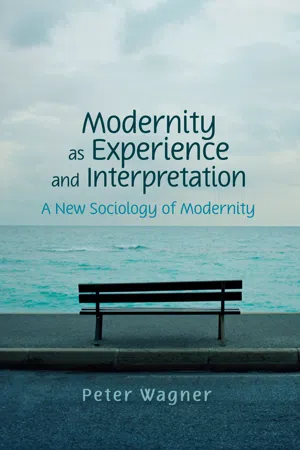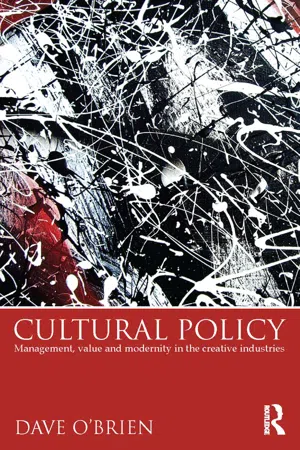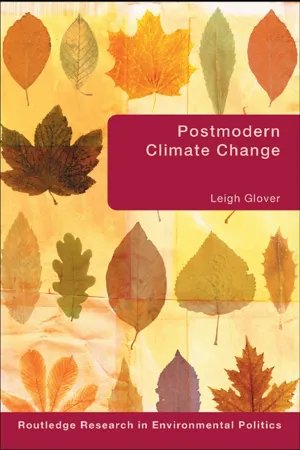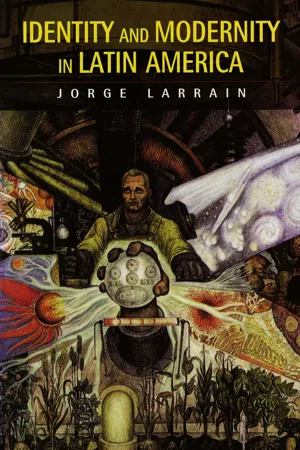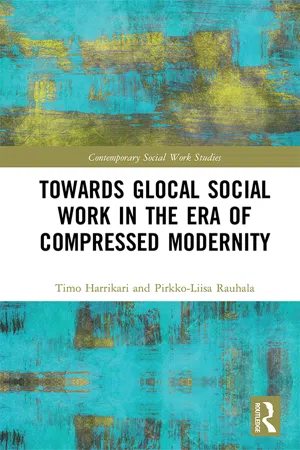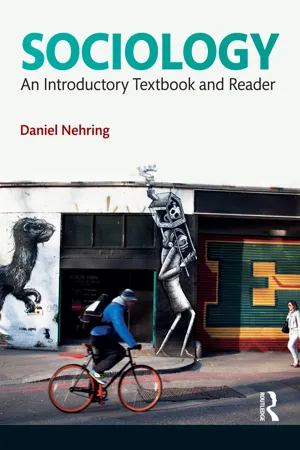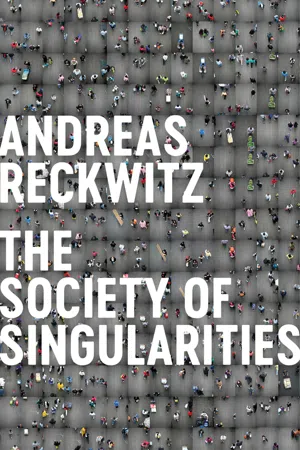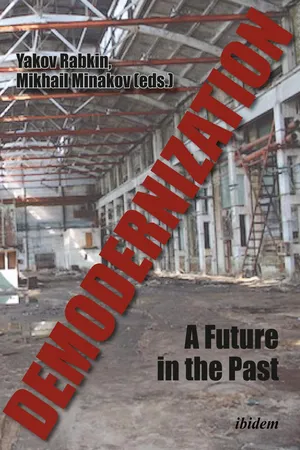Social Sciences
Modernity
Modernity refers to the period marked by significant social, cultural, and technological changes, typically associated with the rise of industrialization, urbanization, and globalization. It is characterized by a shift from traditional to modern ways of life, including changes in political structures, economic systems, and individual values. Modernity often brings about increased individualism, secularization, and a focus on rationality and progress.
Written by Perlego with AI-assistance
Related key terms
10 Key excerpts on "Modernity"
- eBook - ePub
Social Theory in a Changing World
Conceptions of Modernity
- Gerard Delanty(Author)
- 2013(Publication Date)
- Polity(Publisher)
History, as the narrative of the Subject, replaced the Renaissance idea of providence. Modernity thus signifies an epochal movement and is closely related to the liberal idea of progress and the Marxist notion of permanent revolution. This sense of a temporal dimension to Modernity has been closely linked to the idea of modernization in sociological theories, the theory that the evolution of society is to be explained by reference to processes of progressive rationalization, differentiation and individuation. Both the ideas of Modernity as a particular kind of time-consciousness and modernization as a sociological thesis share a common concern with the rise of modern society and the decline of traditional society. The movement from traditional to modern society is thus central to the self-understanding of Modernity and constitutes a master trend of change. In the discourses of Modernity there is only one trajectory, the master trend of change from the premodern – the origin – to the modern, the telos or goal of history. In this book I argue that this definition of Modernity is becoming problematical, since the current situation cannot be defined by reference to the passing of traditional society and the coming of the modern as something post-traditional. The current situation, in fact, points to the passing of the modern itself and the dissolution of the social bond. In order to understand this process we need to go beyond the notion of the post-traditional as well as recognizing the inadequacy of the concept of the postmodern. The older conceptions of Modernity, in contrast, held to a vision of the epochal movement of traditional society to modern society. The defining characteristics of this process of social change were industrialization, individualization, the building of nation-states and the experience of revolution, all of which led to new configurations of time and space - eBook - ePub
- Peter Wagner(Author)
- 2013(Publication Date)
- Polity(Publisher)
experience of Modernity was the centre of attention and, as an experience, it concerned in the first place the human being in her or his singularity, not an exchangeable atom of social life (Berman 1982). Michel Foucault’s lecture ‘What is Enlightenment?’ very succinctly distinguished between those two readings of Modernity. Modernity as an attitude and experience demands the exploration of one’s self, the task of separating out ‘from the contingency that has made us what we are, the possibility of no longer being, doing, or thinking what we are, do or think’ (Foucault 1984, p. 46). This view is opposed to the one that sees Modernity as an epoch and a set of institutions, which demand obedience to agreed-upon rules.In sum, the social sciences have long theorized Modernity as the attempt to grasp the specificity of the present, even though the term ‘Modernity’ has been used only rather recently. The dominant strand in the social sciences has aimed at capturing this specificity by structural-institutional analysis . The modern institutions are here seen as the embodiments of the promise of freedom and reason. Against and beyond this dominant strand, different conceptualizations of Modernity have been proposed. In parallel to the history of the ‘modern social sciences’, the critiques of Modernity have provided an alternative institutional analysis, emphasizing the undermining of the promise of autonomy in and through the workings of the modern institutions. Both the institutional and the critical views have recently been considered too limited in their approach, namely in committing themselves to an overly specific understanding of Modernity. The research and theory during the past three decades that explicitly uses the term ‘Modernity’ is by and large characterized by this insight. The interpretative approach to Modernity has demonstrated the breadth of possible self-understandings of Modernity. The conception of Modernity as an ethos and as an experience - eBook - ePub
Cultural Policy
Management, Value and Modernity in the Creative Industries
- Dave O'Brien(Author)
- 2013(Publication Date)
- Routledge(Publisher)
2 Modernity, GOVERNMENT AND THE SOCIAL LIFE OF METHODSDefining the context for cultural policy DOI: 10.4324/9780203583951-2The term ‘Modernity’ presents an immediate problem. Peter Wagner (2012) , a leading European theorist of Modernity, discusses how the term is deeply controversial, carrying with it at once visions of progress, rationality and human mastery of economy, society and environment, whilst, at the same time, containing the discourses of racism, imperialism and the exploitation of both planet and persons.In a useful summary,Hall et al. (1992)describe how Modernity is not a single historical epoch, as in ‘modern times’, but rather an ongoing process with longstanding and complicated roots. They offer six characteristics (Hall et al. 1992:6) which are essential in understanding the writers who are the basis for this book's discussion. First, Modernity is dominated by institutions which draw authority and legitimacy from secular rather than religious sources, as the state replaces the church as the key organisation in society. This is linked to the second characteristic, whereby secular forms of reason, particularly science, replace religious explanations. Society's social order is changed as the fixed hierarchies and divisions, of classes, ethnicities and genders are challenged by new economic and social relationships. These new economic and social relationships are mediated by monetary exchange, as property ownership and market relations become the norm. Finally, these characteristics are the backdrop for a society of individuals within an individualist culture, a culture which is both the product of and also produces these individuals.It is not at all clear when Modernity begins. Whilst Harvey (1990) dates the end of Modernity to 1972, the roots of Modernity are the subject of the same extensive debate as the meaning of the term. There is some consensus around the idea that the Enlightenment represents the beginning of Modernity (Hall et al - eBook - ePub
- Leigh Glover(Author)
- 2007(Publication Date)
- Routledge(Publisher)
For a condition that embodies contemporary life in developed nations, Modernity is a contentious and elusive concept subject to much sociological inquiry and philosophical contemplation. From the beginning of the industrial era, elements of the ‘modern life’ emerged and were duly considered by thinkers as diverse as Emile Durkheim, Karl Marx, Adam Smith, and Max Weber in an effort that has continued ever since. Scholars differ over what precisely characterizes modernization and the functioning of the societies produced by these processes. Traditional societies exhibit a unity between what modern societies define as identifiable components, such as economy, politics, religion, social relations, education, medicine, and so forth. Modern societies are characterized by urbanity, industrial production, social stratification, social roles taken by professional groups, bureaucracy, and the nation state. Technology is usually taken as a major, if not primary, determinant of the social transformation that culminates in a modern society, wherein all facets of life are technologized.Modernity is distinguished from ‘pre-modern’ or traditional social forms, so that Modernity embraces the character or essence of an entire society, seeking generalities beyond the immediate dynamics and lingering traditions. Dichotomies between the modern and the pre-modern disturb some scholars who fear that modern society be seen as internally uniform, without its own traditions and those remnants of its precursor social forms not be properly acknowledged. Recognizing social and cultural continuities and appreciating local differences with modern society can be valuable in accounting for certain ambiguities and persistent traits, but overwhelmingly modern societies bear little relation to their pre-modern forms, although clearly there are degrees of Modernity.As Toulmin (1990) remarks, given that Modernity can refer to the ‘new,’ to consider ‘the end of Modernity’ is a contemplation of Modernity as an historical era. Yet while the interpretations of Modernity’s beginnings vary, depending on whether one considers the rise of science and technology, architecture, or of politics and philosophy, Toulmin (1990) notes that for most critics the chronology of modernism begins in the early decades of the seventeenth century. - eBook - ePub
- Jorge Larrain(Author)
- 2013(Publication Date)
- Polity(Publisher)
17Modernity is also a vital experience. This aspect has been highlighted in contemporary times by Marshall Berman, David Frisby and David Harvey,18 but its origins can be traced back both to Baudelaire and Simmel. In his famous essay of 1863, ‘The Painter of Modern Life’, Baudelaire stated that ‘by “Modernity” I mean the ephemeral, the fugitive, the contingent, the half of art whose other half is the eternal and the immutable.’19 Simmel, in his turn, very much insisted on the idea of Modernity as a vital experience that privileged the inner feelings of individuals in the face of a complex and changing world. This is why Simmel could define the essence of Modernity as ‘psychologism, the experiencing and interpretation of the world in terms of the reactions of our inner life, and indeed as an inner world’.20 But this new kind of subjectivism is not purely positive; it is also a kind of retreat from the tensions that characterize modern life. In analysing two of the most important sites of Modernity – the advanced money economy and the metropolis – he detects ‘the increase in nervousness and the preponderance of an inner world as a retreat from excessive external stimuli’.21The emergence of Modernity is thus associated with an experience of mobility and social change, with a sense of dynamism; it expresses an overwhelming sense of ephemerality, fragmentation, contingency and chaotic change.22 Modernity not only breaks abruptly with the past but is also characterized by a permanent process of internal ruptures and fragmentation. On the other hand, Modernity nevertheless finds in reason and science a sense of the universal and necessary.23 The simultaneous emphasis on change and science is manifested in what García Canclini calls the renovating project of Modernity: ‘the pursuit of incessant innovation and improvement typical of a relation with nature and society which is free from all sacred prescription as to how the world should be’.24 - eBook - ePub
Towards Glocal Social Work in the Era of Compressed Modernity
Towards an Era of Distorted Modernity
- Timo Harrikari, Pirkko-Liisa Rauhala(Authors)
- 2018(Publication Date)
- Routledge(Publisher)
3 Modernity and social transformation revisitedEven though Richmond’s quote is rather simple, it offers us a starting point and an analytical tool outlining the key changes which an individual faces in his or her environment, or as Richmond describes it, the ‘situation’. We aim to capture her idea of social diagnosis and extend it to the spheres which are not addressed, or at least, are addressed separately from the questions of the casework tradition. Throughout this work, we aim to perform ‘social diagnosis’, which cannot be attributed to any specific person. In particular, we will extend our analysis to the circumstantial evidence which connects people to social networks, systems and institutions in time and space. As we see it, each community is obliged to solve certain system functions, that is, such permanent questions as obtaining livelihood and the modes of production, setting norms and societal goals and the promoting of social relations, solidarity and integration, referring here, for instance, to Talcott Parsons’ AGIL model (Parsons 1970). These functions contain a wide range of economic, ecological, technological, political and social elements which enable and constrain the social work clients’ lives as well as the mandate, goals and methods of the activities called ‘social work’.Modernity is used to describe a narrative on the changes in Western societies. Modernisation theories are used to distinguish between the affirmative and critical approaches. The most famous affirmative theorisations are the classics of social philosophy. In their works, Thomas Hobbes (1651) and John Locke (1698) discussed the transition from a state of nature to a civilised society and the formation of a social contract. Cesare Beccaria, the classic writer in criminal justice, suggested that selfish people made a social contract in order to establish their security, because they were tired of living in a state of war (Beccaria 1764). In his modern classics of social contract theory, John Rawls (1999, original 1971) presented his abstract theory of a veil of ignorance where people would be capable of selecting the best societal principles and making rational political choices apart from their own interests, class position and social status. - eBook - ePub
Sociology
An Introductory Textbook and Reader
- Daniel Nehring, Ken Plummer(Authors)
- 2014(Publication Date)
- Routledge(Publisher)
postmodernité), we can refer to Jameson’s (1984a) account of the Bonaventura Hotel in Los Angeles. Jameson gives a fascinating interpretation of the experience of the new hyperspace of postmodern architecture, which, he argues, forces us to expand our sensorium and body. Yet we get little idea how individuals from different backgrounds actually experience the hotel, or better still, how they incorporate the experience into their day-to-day practices. Perhaps for them to interpret the experience as postmodern they need guidelines to make sense of things they may not fully notice, or view through inappropriate codes. Hence, if we want to understand the social generation and interpretation of the experience of postModernity we need to have a place for the role of cultural entrepreneurs and intermediaries who have an interest in creating postmodern pedagogies to educate publics. The same can be said for two other features of postmodern culture identified by Jameson: the transformation of reality into images and the fragmentation of time into a series of perpetual presents. Here we can take an example which encompasses both features: the media, which tends to be central to many discussions of the postmodern sensibility (one thinks for example of Baudrillard’s simulational world, where ‘TV is the world’). Yet for all the alleged pluralism and sensitivity to the Other talked about by some theorists one finds little discussion of the actual experience and practice of watching television by different groups in different settings. On the contrary, theorists of the postmodern often talk of an ideal-type channel-hopping MTV (music television) viewer who flips through different images at such speed that she/he is unable to chain the signifiers together into a meaningful narrative, he/she merely enjoys the multiphrenic intensities and sensations of the surface of the images. Evidence of the extent of such practices, and how they are integrated into, or influence, the day-to-day encounters between embodied persons is markedly lacking. Thus while learned references to the characteristic experiences of postModernity are important we need to work from more systematic data and should not rely on the readings of intellectuals. In effect we should focus upon the actual cultural practices and changing power balances of those groups engaged in the production, classification, circulation and consumption of postmodern cultural goods, something which will be central to our discussion of postmodernism below.Modernization–postmodernizationOn the face of it, both terms seem to sit unhappily amidst discussion of Modernity– postModernity, modernism–postmodernism. Modernization has been regularly used in the sociology of development to point to the effects of economic development on traditional social structures and values. Modernization theory is also used to refer to the stages of social development which are based upon industrialization, the growth of science and technology, the modern nation state, the capitalist world market, urbanization and other infrastructural elements. (In this usage it has strong affinities with the first sense of Modernity we discussed above.) It is generally assumed, via a loose base–superstructure model, that certain cultural changes (secularization and the emergence of a modern identity which centres around self-development) will result from the modernization process. If we turn to postmodernization it is clear that a concomitant detailed outline of specific social processes and institutional changes has yet to be theorized. All we have is the possibility of deriving the term from those usages of postModernity which refer to a new social order and epochal shift mentioned above. For example, Baudrillard’s (1983a) depiction of a postmodern simulational world is based upon the assumption that the development of commodity production coupled with information technology have led to the ‘triumph of signifying culture’ which then reverses the direction of determinism, so that social relations become saturated with shifting cultural signs to the extent that we can no longer speak of class or normativity and are faced by ‘the end of the social’. Baudrillard, however, does not use the term ‘postmodernization’. - eBook - ePub
- Andreas Reckwitz, Valentine A. Pakis(Authors)
- 2020(Publication Date)
- Polity(Publisher)
Throughout Modernity, a social logic of the general and a social logic of the particular have competed with one another. This basic assumption is the starting point from which this book proceeds. The logic of the general is associated with the social process of formal rationalization, while the logic of singularities is related to a process of culturalization. Whereas, during classical – and, above all, industrial – Modernity, processes of singularization and culturalization represented antipodes to the dominance of the general and were structurally subordinate to it, in late Modernity they have become guiding and formative forces for the whole of society. At the same time, rationalization has changed its form and largely become a background structure for processes of singularization. In order to make a case for this thesis, I will first have to explain certain concepts and my historical schematic. My first goal in this part is to delineate the social logic of the general in classical Modernity and its practice of formal rationalization (1). The next section will describe the concept of singularities, the features of the social logic of the particular, and its practices (2). This will be followed by a discussion of the connection between singularization and culturalization, and remarks will also be made about the revision of a strong concept of culture that revolves around processes of valorization and the question of “value” (3). With this background, it will then be possible to turn to the historical and social development from premodern societies to late Modernity in order to identify phases of cultural transformation in which the social relation between the general and the particular has changed (4).Passage contains an image
1 The Social Logic of the General
Modernity and Generality
What is Modernity? What are the central features of modern society in its classical form? In my view, the answer is clear: the structural core of classical Modernity, since its beginnings in eighteenth-century Western Europe, is a social logic of the general that encouraged the standardization, formalization, and generalization of all entities of society. Modernity fundamentally reformulated the world of traditional societies by thoroughly and relentlessly imposing new forms of the general on their practices, discourses, and institutional complexes. As an overarching praxis, it could be said that Modernity “enacted generality” in the world.Such an understanding of classical Modernity can be associated with a particular sociological theory, but it elevates this theory to a more abstract level as well: Modernity should be understood first and foremost as a process of formal rationalization. For its part, formal rationalization means that Modernity transformed society in such a way that traditional customs were replaced by large-scale complexes of predictable rules, which in turn entailed technically or normatively regulated manners of behavior. Formal rationalization can be derived from the telos of optimization, whose ultimate aims are the efficient processing of nature and the transparent ordering of society. This understanding of Modernity as an elementary process of rationalization is not, however, self-evident. In fact, if one were to ask sociologists about the central features of classical Modernity, one would receive a great variety of answers. Often enough, and especially in Germany, Modernity is equated with a process of functional differentiation. What is meant by this is, accordingly, the differentiation of specialized and functional subsystems (the economy, law, politics, mass media, education, etc.), each of which follows its own self-imposed logic and structure. Although it was Niklas Luhmann who formulated this approach most systematically, its basic ideas extend back to theories about the division of labor. On the international stage, however, another interpretation has been more influential. Going back to Karl Marx, this interpretation treats capitalism as the central organ of Modernity in the form of an economic and technological formation that is oriented toward the uninterrupted accumulation of capital and leads to its vastly unequal distribution. It goes without saying that each of these approaches has identified important characteristics of Modernity. Neither, however, is sufficient. From my perspective, the structure of Modernity will only become comprehensible if one begins with the process of rationalization,1 as Max Weber argued most convincingly.2 Authors as varied as Georg Simmel, Martin Heidegger, Theodor W. Adorno, Hans Blumenberg, Michel Foucault, and Zygmunt Bauman would go on to espouse this idea as well, though each in his own way.3 - eBook - ePub
Education, Work and Identity
Themes and Perspectives
- Michael Tomlinson(Author)
- 2013(Publication Date)
- Bloomsbury Academic(Publisher)
Rizvi and Lingard 2010). This new politico-economic settlement is itself characterized by fluid and cross-global flows in trade, innovation and investment, while also reflecting an increasing consensus between different national governments’ policy strategies.From modern to late modern societyOne of the most marked shifts since the middle to the later part of the twentieth century has been the shift from a traditional society to what has often been termed a modern or late modern society. This has been described by a number of key sociologists, such as Giddens (1990, 1994) and Bauman (2000). Traditional societies are largely based on established and set social and economic boundaries, often fixed within fairly defined time and space dimensions and tightly regulated forms of social practice and consumption. Moreover, traditional societies tend to be predictable and routine. Customs dominate and past actions and practices are heavily drawn upon as a key reference point for understanding social life.A combination of technological, economic and lifestyle changes since the early part of the twentieth century have gradually eroded the traditional underpinnings of society. The shift towards Modernity, therefore, has seen widespread disruption to highly patterned and routine ways of life. For Giddens (1990), three core processes underpin Modernity. These are distanciation , that is, the increasing separation between time and space; individuals’ experiences are no longer strongly bound by fixed and immediate social exchanges and interactions. Consequently, people have become increasingly disembedded from very immediate, specific and localized social contexts. They have effectively become ‘lifted out’ of the confines of space and time and become subjected to a broader array of social experiences. Late Modernity is also characterized by increasing reflexivity: - eBook - ePub
Demodernization
A Future in the Past
- Mykhailo Minakov, Yakov Rabkin(Authors)
- 2018(Publication Date)
- Ibidem Press(Publisher)
Which Modernity? Which Demodernization?
Jean-Luc GauteroBeyond their differences, the numerous characterizations of modernization (and thus of its product, Modernity) seem to have one thing in common: They regard it as the association of heterogeneous and even contradictory items. Habermas (1984) sees in it “a decentered understanding of the world,” which “on the one hand” “opens up the possibility of dealing with the world of facts in a cognitively objectified [versachlicht] manner and with the world of interpersonal relations in a legally and morally objectified manner” and which “on the other hand […] offers the possibility of a subjectivism freed from imperatives of objectification in dealing with individualized needs, desires, and feelings” (p. 216); Bruno Latour (1993) presents the hypothesis “that the word ‘modern’ designates two sets of entirely different practices which must remain distinct if they are to remain effective” (he calls them “translation” and “purification”) (1.5). But above all we have to quote Alain Touraine (2000), who introduces the concept of demodernization in relation with such a characterization of modernization: “Whereas ‘modernization’ meant using the idea of a national society to manage the duality of rational production and the Subject’s inner freedom, demodernization is defined by the breaking of the links that bound together personal freedom and collective efficacy” (p. 25). What he writes here about modernization is nothing but a slight reformulation of what he has written previously about Modernity:If the classical image of society is shaped by the interaction of three elements—rationalization, ethical individualism and institutional functionalism—the third element is the corner-stone of the system, as I have defined Modernity in terms of the growing dissociation of system and actor, and therefore in terms of the disappearance of any meta-social principle that can make them complement one another. Rather than forming an articulated whole, the market economy and the autonomy of private life (or consciousness) tend to contradict one another. (p. 22)
Learn about this page
Index pages curate the most relevant extracts from our library of academic textbooks. They’ve been created using an in-house natural language model (NLM), each adding context and meaning to key research topics.

